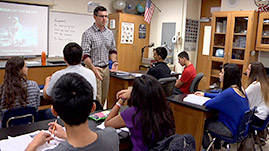Teachers' Domain - Digital Media for the Classroom and Professional Development
User: Preview



Executive Producer Jill Peters
Producer Michelle Chen
Associate Producer Eliana Cruz
Content Producer Sybil Berry
Camera Greg Barna, Michael Pruitt-Bruun
Audio Ken Chin
Editor Michiel Pilgram
Re-recording Mixer Jon Berman
Music Supervision Rosie Fishel
Senior Budget Controller Rekha Menon
Intern Megan Schumm
Special Thanks to Herricks High School, Ward's
Director of Children's and Educational Media Sandra Sheppard

Google Moon provides a photographic map of the moon with pan and zoom capability. It also shows the locations of the Apollo flight landings.
Use this resource to help frame your lesson and provide a deeper understanding of the history of Moon exploration. Click the charts button to reveal a set of geologic and topographic charts. Students can use these to study the topical composition of the moon and to investigate the commonalities and differences between the Moon’s composition and the Earth’s inner core.
Implementing the Common Core in the Science ClassroomAndrew Cloud brought the Common Core State Standards into his science classroom by selecting the Origin of the Moon background essay on PBS LearningMedia. He asked his students to read each paragraph of the text carefully and to write a topic sentence for each paragraph.
You may have also noticed that Andrew paired the Origin of the Moon background essay with the Evolution of the Moon video. After doing a search for supporting resources, Andrew felt that the Origin of the Moon essay was the best fit for the lesson he was teaching. Feel free to follow his lead and do the same.
Using VideoWhen showing a video always provide a Frame, a Focus and a Follow-up:
FrameProvide a context that helps students pay attention to the main content of the video. Ask students questions about the topic explored in the video to activate prior knowledge.
FocusHelp students notice the important moments in the video by providing them with a specific focus, something to look for while they watch.
Follow-upProvide an opportunity for students to summarize and discuss what they saw. Re-telling what they saw helps students consolidate their understanding and remember it.
Play the video multiple times to enhance understanding. Depending on your classroom set-up or the availability of computers or tablets, play the video for the entire class or encourage students to watch independently or in small groups.
Pause the video at particular moments to review content or let students take notes. Let students know it is okay to play the video as many times as necessary to gain a full understanding of the content.
 Loading Standards
Loading Standards